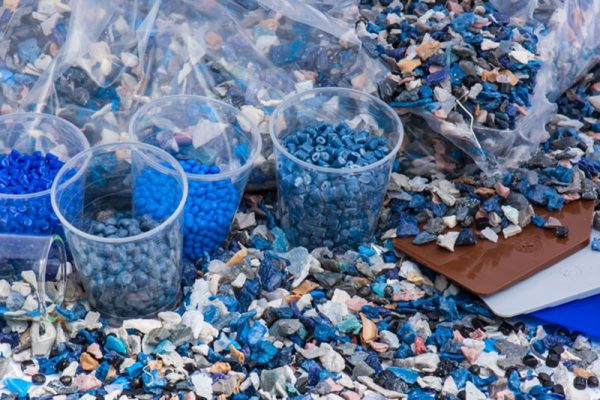Recycled ABS is a fairly common plastic, with a strict production process at TAELIM. In the following article, we will share about the process of creating standard recycled plastic and important additives for you to understand.
Learn about recycled ABS
Recycled ABS is a type of plastic produced from used plastic materials. This recycling process includes many separate steps of classification and processing. First, the collected plastics will be crushed for easy processing. Next, they will be cleaned and dried to remove impurities. Finally, the plastic will be melted and transferred to an extruder to create plastic fibers or granules. Recycled plastics have wide applications in many fields such as industry, construction and environmental protection.

Can recycled ABS be recycled?
ABS plastic, like many other plastics, has the disadvantage of being difficult to decompose in nature. If plastic waste is not properly treated, it can be harmful to the environment and unsightly. To exploit the value of this waste, researchers have developed ABS plastic recycling technology, which helps turn waste plastic into recycled ABS plastic.

Recycled ABS recycling code
To facilitate sorting, the recycling industry has established a coding system to identify each type of plastic. For recycled plastics, this coding is usually printed on the bottom of the product, with a logo consisting of the letters “ABS” surrounded by arrows, making it easy to identify and sort the product during the recycling process.
Recycling process of recycled ABS
The 3D printing industry is booming, with many people owning 3D printers at home and recycling ABS plastic for raw materials. This has expanded the ABS plastic recycling process beyond professional factories. However, whether at home or in a factory, the ABS plastic recycling process still takes place in three main steps, specifically shared below.
Classification and screening
The recycling process begins with the collection of products that are made entirely of plastic or have plastic parts, such as helmets and phone cases, when they are damaged beyond repair. Here, items made of ABS plastic are separated from other types of plastic. This step also includes the removal of debris and impurities.

Mill
After the screening process is complete, the recycled ABS products are crushed into small pieces. Factories often use a dual-shaft plastic shredder or a specialized hydraulic plastic crusher. For those doing it at home, crushing ABS plastic can be difficult because household crushers are not designed for this purpose.
Whether you grind it at home or in a factory, the process is easy but time-consuming. Recycled ABS has a very solid structure, so grinding it into small pieces is often a laborious task. After grinding, the plastic pieces will be cleaned and dried again.

Melting and molding of recycled ABS
After drying, the plastic flakes are melted into liquid form. This plastic mixture is then fed into a press to form fibers or pellets, which are then supplied to manufacturers to make new products. Recycled ABS plastic, with its low cost and suitable properties, stands out from other recycled plastics such as PP, PVC, LDPE and HDPE, and is becoming a popular choice in the industry.

>>> See more: Characteristics and Applications of PVC Plastic Granules in Life
Synthesis of additives of recycled ABS
To create a complete ABS plastic product, the manufacturer will need to use some necessary additives, specifically as follows.
Processing aids
During processing, some manufacturing processes can cause wear and tear on machinery or affect the quality of the final product. Processing aids are added to polymers to reduce friction between the plastic and machinery, helping to improve manufacturing efficiency.
This additive not only promotes melting but also allows efficient processing of high molecular weight polymers without negative technical effects on the product. This additive has many applications in industries such as blown film, extrusion and injection molding, helping to improve processing efficiency and enhance product aesthetics by minimizing scratches and creating a glossy surface.

Regenerated ABS Deodorizer Additive
Odors from plastics, especially recycled plastics, can reduce the value and competitiveness of products. Therefore, odor removal is essential to improve the efficiency and value of plastics in production. Deodorizing additives act as a neutralizer, not replacing the original odor of the product but preventing the absorption of unwanted odors and irritating chemicals. This solution is commonly used in rubber plastic products and items made from regrind materials, such as household appliances, toys and textile packaging.

Desiccant
The desiccant contains Calcium Oxide (CaO), a substance with strong water absorption capacity. During the processing of recycled ABS, Calcium Oxide helps to remove moisture and prevent phenomena such as fisheye. It is especially useful in extrusion (film blowing, film casting, blow molding, etc.) and injection molding applications, especially for recycled plastics. By removing moisture, this additive also helps to prevent oxidation during the plastic recycling process, thereby improving the quality of the final product.
Recently, TAELIM has provided detailed information about recycled ABS with the production process and commonly used additives to create a finished product. Surely through this, you have understood more about this type of plastic and its formation process.

>>> See more: Properties of HDPE and Accurate Collection and Recycling Process
TAELIM International Transport Company Limited
With the desire to support the development of the plastic industry by providing high quality plastic pellets and services. Taelim Plastic is one of the Vietnamese plastic companies with many years of experience, with a long history of development, specializing in the production, trading, import and export of recycled pellets. By applying advanced technology, meeting European standards with a strict process, we ensure to bring customers the best products and services.
ADDRESS: SH109 Vinhomes Marina, Hai Phong
PHONE: (+84) 9815 888 16
EMAIL: hatnhua.taelim@gmail.com



